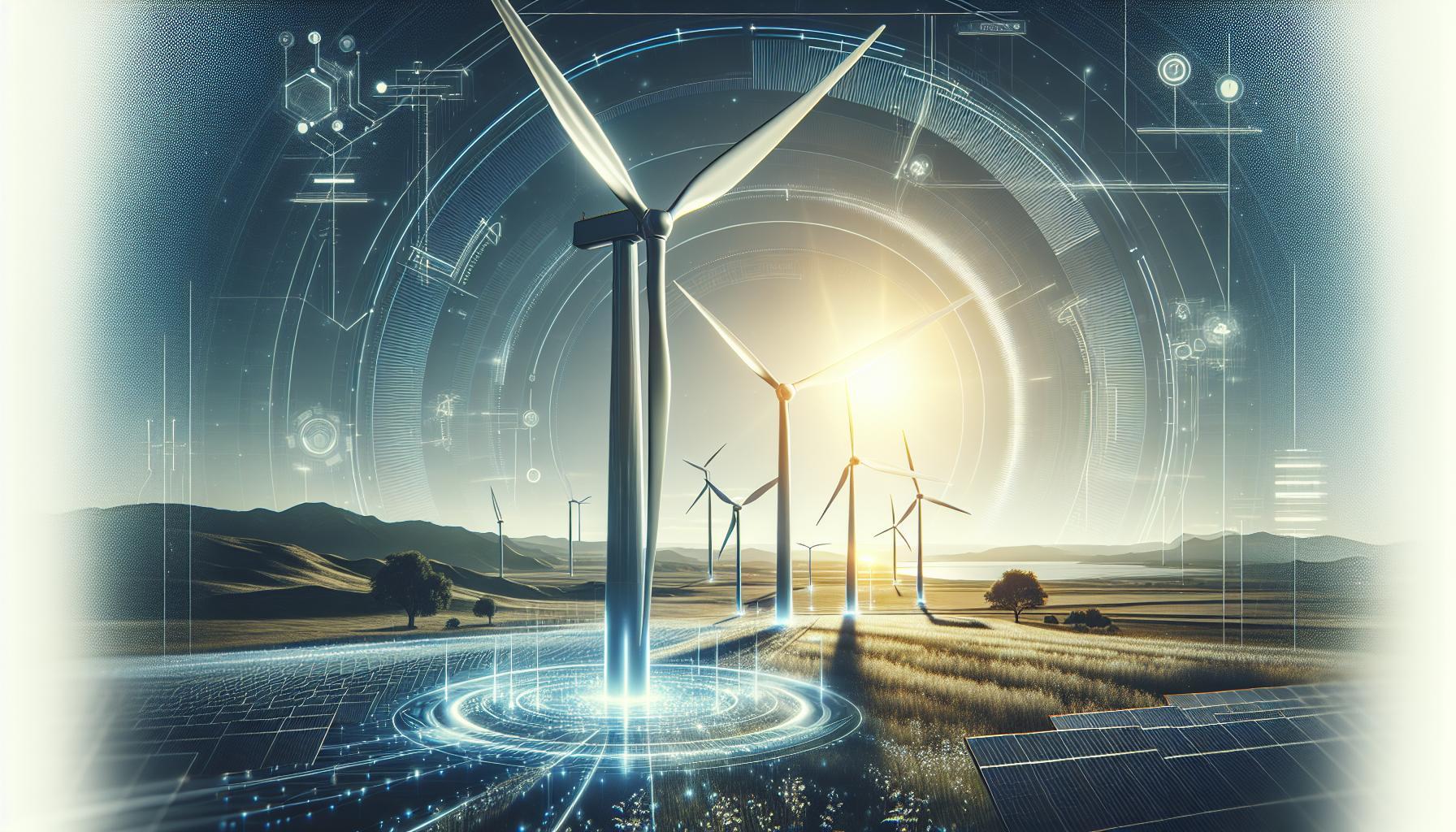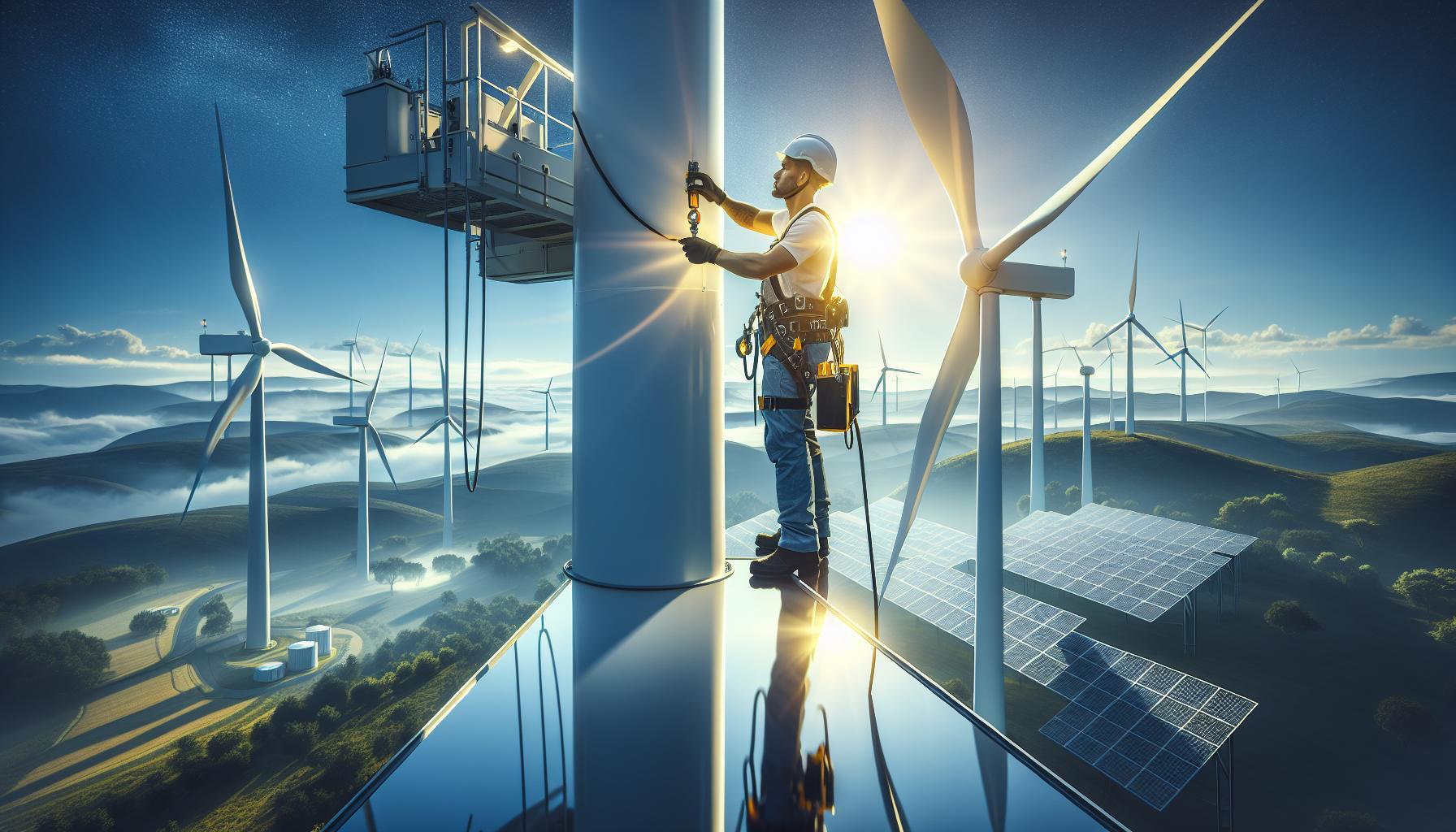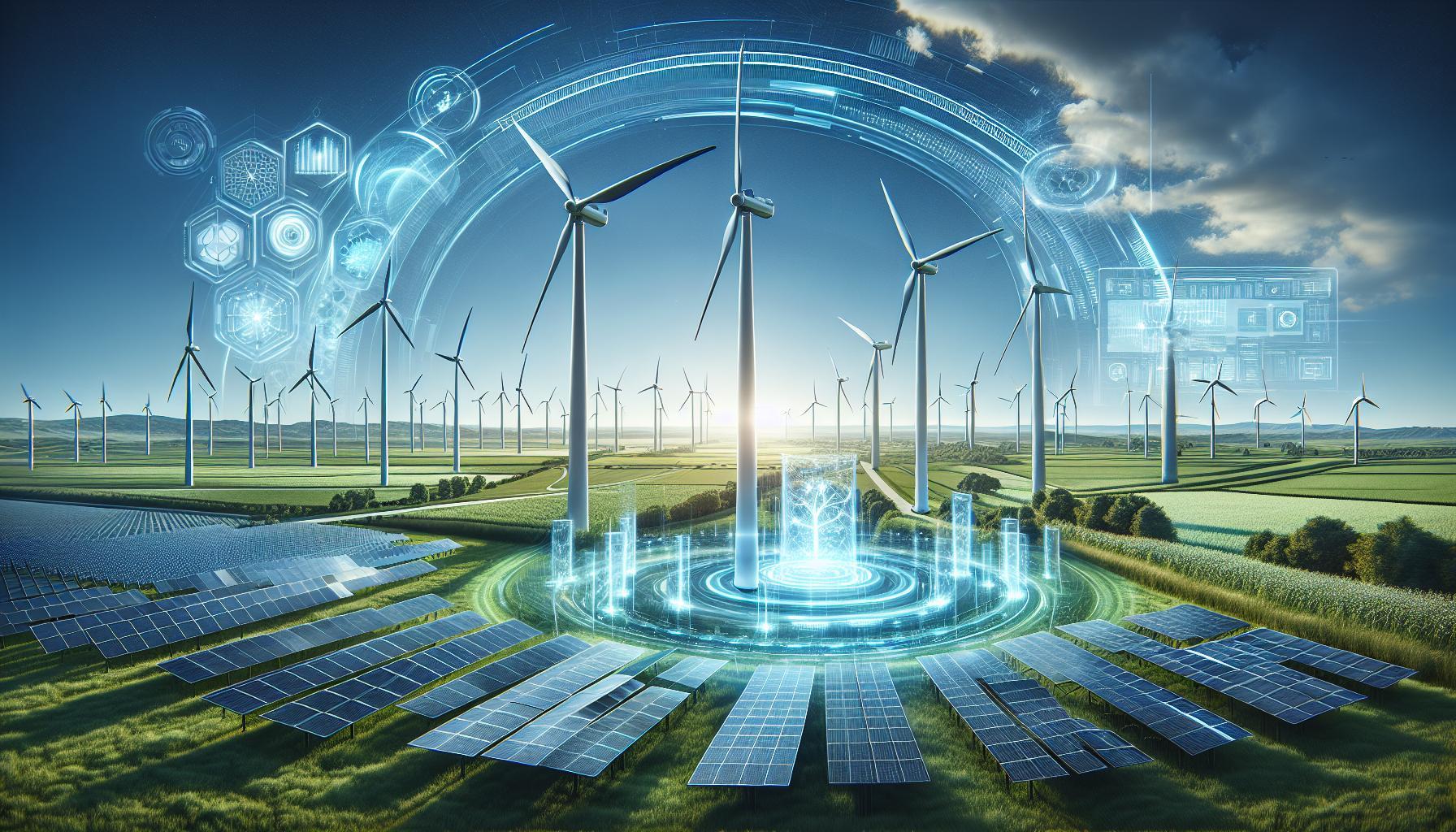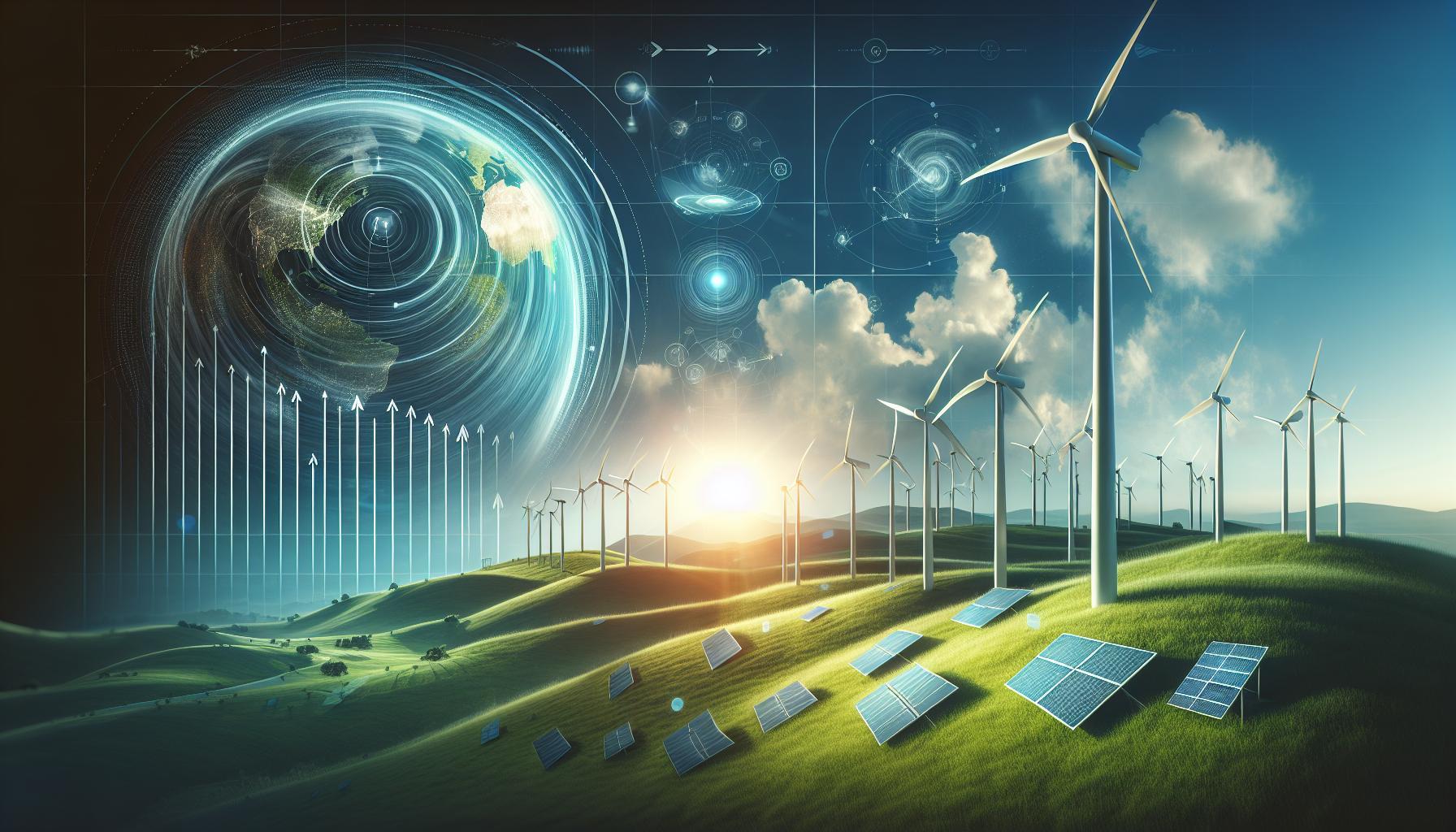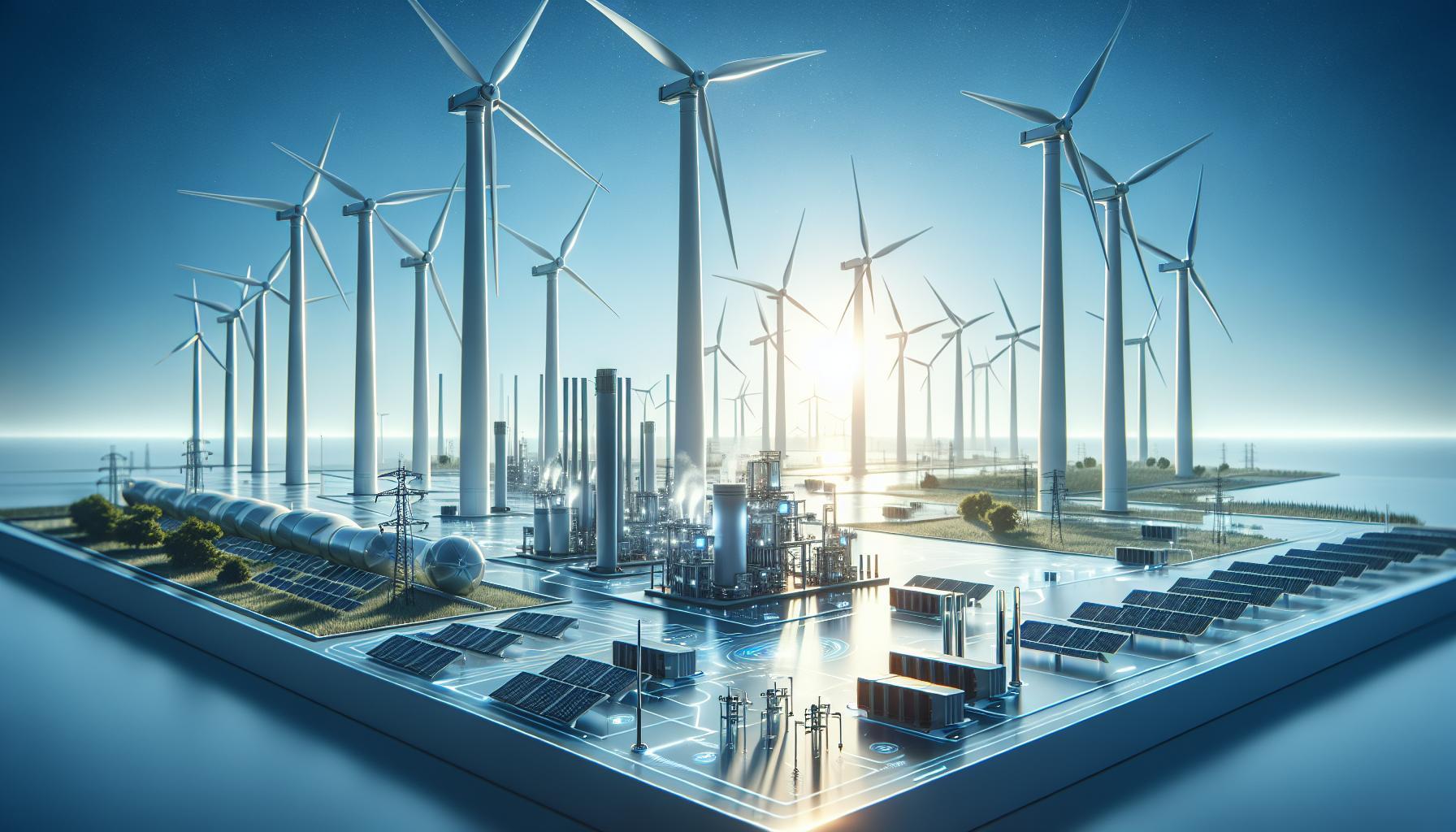Did you know that over 60% of wind turbine shutdowns are due to maintenance and operational factors? This not only impacts energy production but also raises concerns about reliability in the renewable energy sector. Understanding why wind turbines stop is essential for anyone interested in clean energy, from homeowners considering wind power to industry professionals.
As global demand for renewable energy surges, ensuring the efficiency and durability of wind turbines is more crucial than ever. Turbines play a vital role in reducing carbon footprints and combating climate change, so addressing the reasons behind their shutdowns helps safeguard our investment in sustainable technology.
Curious about what takes these giants of green energy offline? In this article, we delve into the top reasons for turbine shutdowns, shedding light on the complexities of wind turbine operations and the steps that can be taken to maximize their performance. Join us as we explore this vital aspect of renewable energy and discover solutions to keep the wind blowing efficiently.
Understanding Wind Turbine Operations and Shutdowns
Wind turbines are often celebrated as symbols of green energy, harnessing nature’s power to generate electricity without emitting pollutants. However, what happens when these towering structures, designed for optimal performance, must come to a halt? Understanding the operations of wind turbines and the circumstances that lead to their shutdown is crucial not only for industry professionals but also for anyone invested in renewable energy.
A wind turbine functions by converting kinetic energy from the wind into mechanical energy, which is then transformed into electrical energy. Various systems are at play to ensure turbines operate efficiently, including rotor blades, gearboxes, generators, and control systems. Yet, when conditions aren’t ideal, safety protocols necessitate a shutdown. For instance, turbines are equipped with sensors that monitor wind speed, temperature, and mechanical integrity. If wind speeds exceed safe operational thresholds-typically around 25 meters per second (56 miles per hour)-the turbine will automatically disengage to prevent mechanical failure. This intelligent design underscores a fundamental truth in wind energy operations: safety is paramount.
Several factors can trigger a turbine shutdown, not all of which are the result of unfavorable wind conditions.
Common Shutdown Triggers
- Technical Failures: Mechanical issues such as gearbox failures or electrical malfunctions can necessitate immediate shutdowns to prevent further damage.
- Maintenance Needs: Scheduled maintenance is crucial for ensuring turbine longevity and efficiency. Turbines may shut down temporarily for routine inspections or repairs.
- Environmental Changes: Harsh weather conditions, including ice accumulation on blades or extreme temperatures, may force a turbine to halt operations.
Moreover, the wind industry continuously evolves, with innovations aimed at enhancing reliability and minimizing downtime. Advanced predictive maintenance technologies, for example, utilize data analytics to anticipate failures before they occur, allowing for efficient scheduling of repairs without compromising operational capacity.
By grasping the complexities surrounding wind turbine operations and shutdowns, stakeholders can work towards optimizing the performance of these renewable energy sources, further advancing the clean energy agenda. Understanding these nuances not only ensures that the technology remains effective but also builds public trust in wind energy as a viable and sustainable solution for our energy needs.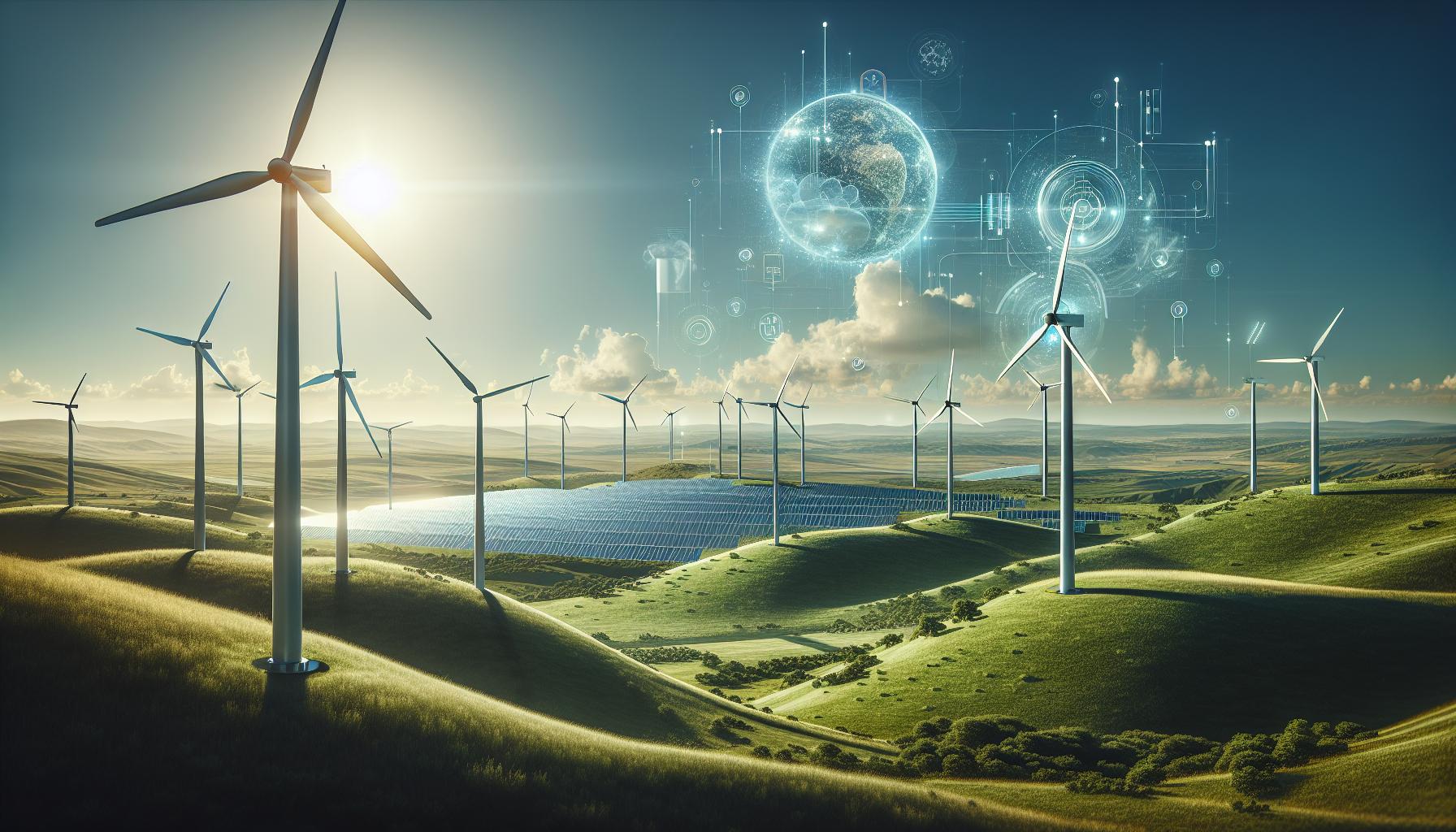
Common Reasons for Turbine Shutdowns
Wind turbines, a key component of the renewable energy landscape, occasionally need to stop functioning, even during optimum wind conditions. The reasons behind these shutdowns range from technical issues to environmental influences, highlighting the complexities involved in operating these innovative machines. Understanding these triggers not only aids operators in optimizing performance but also reassures the public of the reliability and safety inherent in wind energy technology.
One of the most significant contributors to turbine shutdowns is technical failures. Wind turbines encompass a range of intricate components, including gearboxes, generators, and pitch systems, all of which are susceptible to wear and tear. For example, a common issue is gearbox failure, which can arise from mechanical stress or poor lubrication. When such failures occur, immediate shutdown becomes imperative to prevent escalating damage and costly repairs. Regular inspections and maintenance are vital in mitigating these risks, as they allow operators to address potential weaknesses before they escalate into major failures.
Another common cause of turbine shutdowns is the need for scheduled maintenance, which is essential for maximizing the efficiency and longevity of the equipment. Much like a car needs regular servicing, wind turbines benefit from routine inspections that can detect wear, diagnose problems, and perform necessary repairs. This process ensures that turbines operate at peak efficiency when energy demand is high. Maintenance activities might include replacing worn components, checking electrical connections, and inspecting the condition of rotor blades. For instance, a turbine may be shut down for blade inspections to assess for erosion or damage from harsh weather elements, ensuring safe and efficient operation during the next wind cycle.
Environmental conditions also play a critical role in turbine operations. Extreme weather events, such as ice storms or heavy snowfall, can inhibit a turbine’s ability to rotate freely and may cause significant mechanical strain. Ice accumulation on turbine blades can affect aerodynamic performance, leading to inefficient energy conversion and, ultimately, a necessary shutdown to allow for defrosting and maintenance. Moreover, high winds exceeding the standard operational threshold (often around 25 meters per second) prompt automatic disengagement of the turbine to protect its machinery from damage.
In summary, understanding why wind turbines stop is vital for enhancing their operational reliability. By addressing technical failures, performing regular maintenance, and adapting to environmental changes, operators can significantly reduce downtime. As wind energy continues to evolve, these insights will support both individual projects and the broader transition to renewable energy solutions, contributing to a more sustainable future.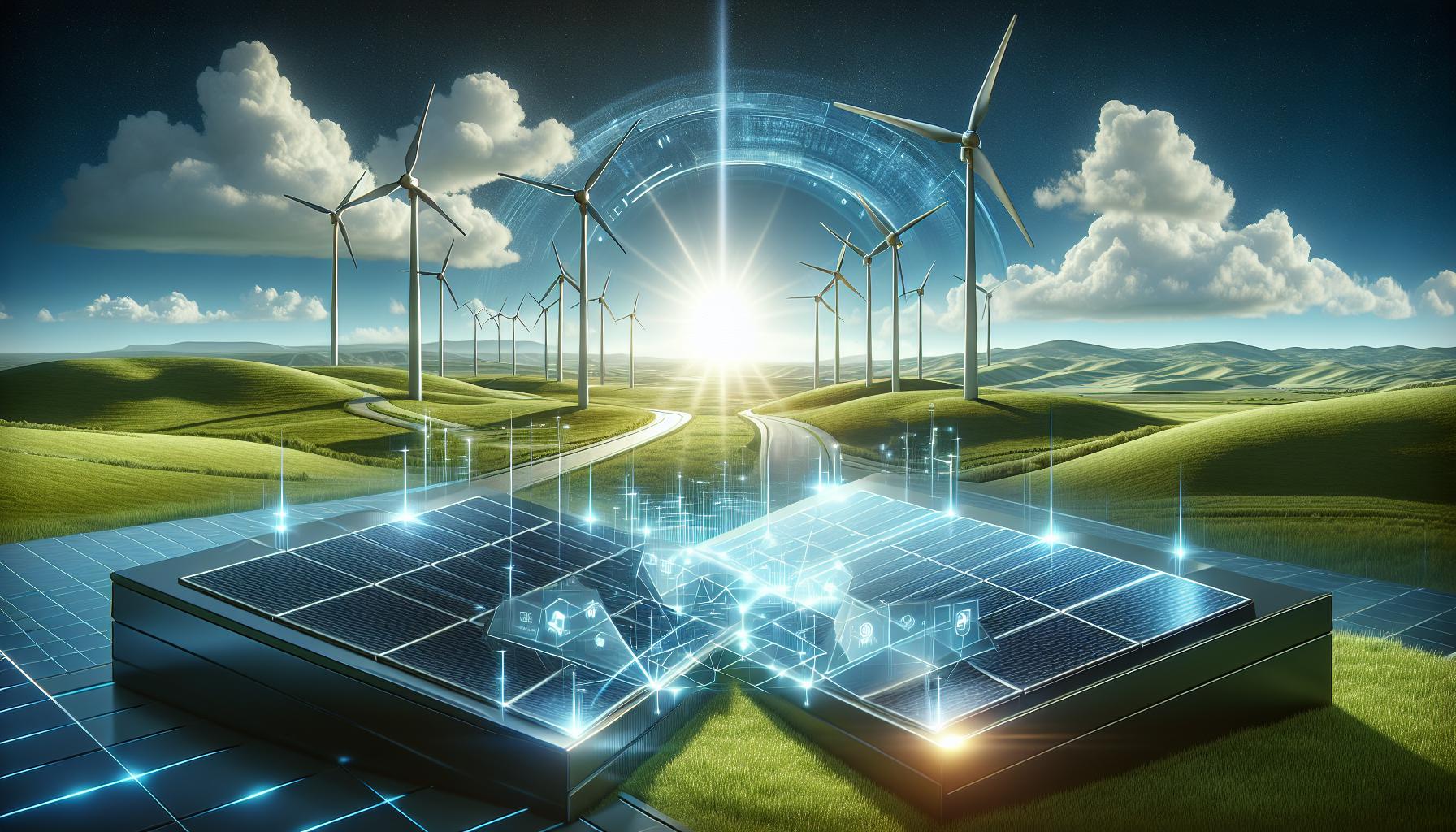
Safety Protocols Leading to Shutdowns
Wind turbines are engineering marvels designed to harness the power of the wind efficiently, but with their complex machinery comes the imperative need for safety. One integral aspect of wind turbine operations is adhering to stringent safety protocols, which sometimes necessitate shutdowns. These protocols are established not just to protect the machinery but also to ensure the safety of the environment and nearby personnel. Understanding the rationale behind these safety measures helps both engineers and the general public appreciate the thoughtful engineering that is inherent in wind energy technology.
Preemptive Safety Measures
To maintain optimal operational safety, wind turbines are equipped with various sensors that continuously monitor key performance indicators such as temperature, vibrations, and rotational speeds. When the sensors detect anomalies that could signal the onset of a mechanical failure or hazardous condition-like a sudden spike in vibration due to ice formation or component wear-a shutdown is automatically triggered. For instance, if a turbine’s pitch control system indicates that blades are not adjusting efficiently to high wind speeds, the turbine will disengage to prevent excessive strain that could lead to catastrophic failure. This preemptive approach ensures that minor issues are addressed before they evolve into major concerns, safeguarding both the turbine and the surrounding area.
Emergency Shutdown Protocols
In addition to routine monitoring, wind farms implement comprehensive emergency response protocols that are activated under particular environmental or operational conditions. For example, if lightning is detected in proximity to the turbine, a safety shutdown occurs immediately. This is critical because lightning strikes can cause serious damage not only to the turbine components but also pose risks to onsite personnel. Operators are trained rigorously to follow these protocols, which include systematic evaluation of the turbine’s condition, contacting emergency maintenance crews, and notifying local safety authorities if necessary.
These safety protocols serve not only to protect the wind turbines themselves but also to foster public trust in renewable energy solutions. The commitment to safety reflects an overarching aim to create a sustainable energy future. As technology improves and safety measures become more sophisticated, reliance on wind energy is only expected to grow, leading to fewer shutdowns and enhanced operational confidence in these green energy generators.
Through these rigorous safety protocols, the wind energy industry emphasizes its dedication to both innovation and the well-being of communities, further solidifying its role in the transition towards cleaner energy solutions.
Environmental Conditions Affecting Turbine Performance
Wind turbines thrive on the invisible currents of the atmosphere, yet their performance is inherently influenced by a variety of environmental conditions. Factors such as wind speed, temperature, humidity, and even the local geographical landscape play significant roles in operating efficiency. For instance, extreme weather conditions are not only a challenge but can also trigger operational shutdowns to prevent damage to both the turbine and associated hardware.
One of the most critical factors impacting turbine performance is wind speed. Wind turbines are designed to operate within a specific range known as the cut-in wind speed, at which they begin generating power. If wind speeds surpass the cut-out threshold-typically around 25 meters per second (approximately 56 miles per hour)-the turbine automatically shuts down. This precaution protects the turbine’s mechanical systems from excessive stress and potential failure. Engineers employ designs that are tested to withstand high loads, but extreme weather events like hurricanes can still pose a significant risk. Therefore, understanding wind dynamics, such as gusts and sustained high winds, is crucial for optimizing turbine operation and maintenance schedules.
Temperature Impacts
Temperature variations also impact turbine functionality in profound ways. Cold weather can lead to icing on blades, which not only affects aerodynamic efficiency but may also trigger protective shutdowns to avoid mechanical failure. Similarly, extremely high temperatures can cause thermal expansion of materials or compromise lubricant efficacy, necessitating careful monitoring. Operators need to proactively manage temperature-related challenges by employing antifreeze systems in colder climates and ensuring that cooling systems are functioning optimally in hotter regions. Additionally, maintaining an effective operational strategy can involve altering turbine settings or scheduling downtime during harsh environmental conditions.
Geographical and Seasonal Considerations
The geographical terrain where a wind farm is installed also plays a significant role in turbine performance. Mountains, valleys, and bodies of water can create unique wind patterns that vary considerably within small geographic areas. This variability requires meticulous site analysis prior to turbine installation to ensure optimal performance year-round. Seasonal changes further compound this variability; for example, winter months may bring stronger winds but also the possibility of icing, while summer may reduce wind speed but require extensive cooling measures.
In conclusion, understanding the interplay between environmental conditions and wind turbine operations is essential for maximizing performance and minimizing unwanted shutdowns. Operators and engineers must remain vigilant, employing responsive strategies to weather challenges and ensuring consistent energy production. By embracing advanced monitoring technologies and maintaining flexibility in operational protocols, the wind energy sector can continue to evolve, optimizing its incredible potential as a clean, renewable energy source.
Technical Failures and Maintenance Issues
The reliability of wind turbines is crucial in delivering consistent renewable energy, yet can lead to operational downtime. A staggering percentage of turbine shutdowns stems from mechanical malfunctions, which highlight the importance of rigorous design and maintenance protocols within the wind energy sector. From gearbox failures to electrical malfunctions, understanding the root causes of these issues can significantly inform preventative measures and maintenance schedules.
Common technical failures often originate from the complex systems that wind turbines rely on for safe and efficient operation. Key components such as gearboxes, generators, and control systems can encounter problems due to wear and tear, environmental stress, or manufacturing defects. Approximately 22% of turbine downtime is attributed to gearbox failures, emphasizing the need for high-quality materials and precision engineering. For instance, regular vibration analysis and condition monitoring can help detect anomalies early, allowing for timely interventions that prevent catastrophic failures.
Proactive Maintenance Strategies
To mitigate the risks associated with technical failures, operators should adopt proactive maintenance strategies that emphasize predictive and preventive practices. This can include regularly scheduled inspections, sensor-based monitoring systems, and the use of advanced analytics to forecast equipment issues before they result in shutdowns. Implementing a robust maintenance schedule not only ensures the longevity of turbine components but can also enhance overall efficiency and performance.
- Predictive Maintenance: Utilizing IoT sensors and data analytics to monitor turbine health in real-time.
- Regular Inspections: Conducting routine assessments of critical components like blades, hydraulic systems, and electrical connections.
- Oil and Lubrication Management: Ensuring optimal lubricants are used and maintained to prevent overheating and wear in mechanical components.
Real-World Examples and Innovations
Innovation plays a vital role in reducing the frequency of technical failures. For example, the introduction of condition-based maintenance strategies in some wind farms has led to a significant decrease in unexpected downtimes. Companies like Siemens Gamesa have developed advanced turbine designs that incorporate self-diagnosing technology, capable of identifying mechanical issues and alerting operators before shutdowns occur. Utilizing these innovations not only enhances reliability but also minimizes the carbon footprint associated with maintenance operations.
In summary, addressing is essential for optimizing wind turbine performance. By employing advanced monitoring techniques, embracing innovations in turbine design, and adhering to rigorous maintenance schedules, operators can substantially reduce downtime. This proactive approach contributes not only to the operational efficiency of wind farms but also to the broader goals of promoting sustainable energy solutions for a cleaner future.
The Role of Wind Speed in Turbine Efficiency
Wind turbines are designed to harness the power of wind to generate clean electricity, but the relationship between wind speed and turbine efficiency is complex and critical. Understanding how wind speed influences turbine performance not only enhances energy production but is also vital for minimizing shutdown incidences. Each turbine has a specific operational range, known as the cut-in speed, rated speed, and cut-out speed, which dictates its performance and reliability.
When a wind turbine operates within its optimal wind speed range, typically between 10 to 25 miles per hour (mph), it can generate maximum energy output efficiently. However, if wind speeds drop below the cut-in speed, around 3 to 4 mph, the turbine does not generate energy, leading to a temporary shutdown. Conversely, if wind speeds exceed the cut-out speed, typically around 55 mph, the turbine must shut down to prevent damage to its components. This highlights the dual nature of wind as a powerful energy source and a potential force for mechanical strain.
Monitoring and Controlled Shutdowns
To manage the impact of variable wind speeds, operators employ sophisticated monitoring systems that can provide real-time data regarding wind conditions. These systems enable turbines to adjust their blade pitch and orientation to optimize performance. For example, modern turbines utilize pitch control systems to angle the blades for maximum efficiency during high wind, while yaw control systems ensure they face directly into wind gusts. Such proactive measures not only enhance energy production but also reinforce the turbine’s structural integrity, reducing the risk of shutdowns caused by excessive wind stress.
Real-World Example: The Effect of Wind Speed Variability
Consider a wind farm located in a region characterized by strong coastal breezes. During periods of unstable weather patterns, wind speeds may fluctuate widely, leading to an increased frequency of turbine shutdowns. Turbines equipped with advanced control systems have shown to fare better in these conditions, allowing operators to maximize their uptime and energy output even in the face of challenging weather. By contrast, older turbine models without such adaptability often faced more frequent and prolonged downtimes, reinforcing the importance of innovation in wind turbine design.
Moreover, understanding the statistical distribution of wind speeds-known as the Weibull distribution-can also guide developers in selecting sites for new wind farms, ensuring that turbines are positioned in areas with reliable wind resources. By focusing on sites with optimal wind patterns, developers can dramatically improve turbine efficiency and reduce the number of unnecessary shutdowns, contributing to a more robust and reliable energy supply.
Thus, wind speed is not merely a factor in the operation of wind turbines; it is a critical element that dictates when and how these machines operate. By incorporating robust monitoring and optimization technologies, the wind energy sector can enhance turbine reliability and ensure a consistent and sustainable energy output.
Grid Connection Challenges and Their Impact
The interconnectedness of wind energy production and the electrical grid presents both opportunities and challenges for the viability of wind farms. A captivating fact is that, according to the U.S. Energy Information Administration, wind energy accounted for about 8% of total U.S. electricity generation in 2021, yet the potential for even greater contributions remains hampered by grid connection challenges. These obstacles often lead to unexpected turbine shutdowns, as operators must navigate the complexities of integrating renewable energy sources into an existing infrastructure designed for more traditional power generation.
At the core of grid connection challenges are issues related to capacity and reliability. During periods of low demand, a wind farm may generate energy that exceeds the grid’s capacity to handle additional power, particularly in regions where transmission lines are already operating near their limits. This surplus can trigger automatic curtailment, forcing turbines to shut down as a precaution. Such scenarios are not only frustrating for energy producers attempting to meet sustainability goals, but they also highlight the importance of investing in smarter grid technologies and enhanced energy storage solutions.
Addressing Grid Connection Challenges
- Upgrading Infrastructure: One practical approach is to upgrade existing transmission lines to accommodate increased wind energy capacity. This involves not only reinforcing physical structures but also implementing advanced technologies such as high-voltage direct current (HVDC) systems, which can efficiently transfer electricity over long distances and integrate with multiple renewable sources.
- Distributed Energy Resources: Integrating distributed energy resources (DERs)-like battery storage or local solar installations-can alleviate stress on the grid. By storing excess wind-generated energy for use during peak demand times, operators can reduce the frequency of turbine shutdowns and increase overall energy reliability.
- Demand Response Strategies: Implementing demand response programs, which adjust electricity usage based on availability, can also play a critical role in balancing supply and demand. These programs allow grid operators to communicate directly with large energy consumers, incentivizing them to reduce consumption during periods of excess generation, thereby preventing the need for turbine shutdowns.
Real-World Example: Texas Power Grid
In Texas, the Electric Reliability Council of Texas (ERCOT) has navigated these challenges more uniquely by adopting measures to support its growing wind energy sector. For instance, during high production periods, ERCOT has effectively managed the fluctuation in wind energy by coupling it with natural gas and additional energy resources, thereby minimizing shutdowns. This layered approach allows for a more resilient grid capable of accommodating the variable nature of wind generation.
Ultimately, understanding the implications of grid connection issues not only helps enhance turbine performance but also strengthens the entire renewable energy ecosystem. By prioritizing infrastructure improvements and fostering technological innovation, we can pave the way toward a future where wind energy operates seamlessly within our power grids, ensuring that these clean power sources fulfill their potential in combating climate change and promoting sustainable energy practices.
Scheduled Maintenance and Upgrades
Scheduled maintenance is a cornerstone of wind turbine operations, playing a crucial role in ensuring both the efficiency and longevity of wind energy production. Just like a car requires regular service check-ups to run smoothly, wind turbines depend on systematic inspections and upgrades to minimize downtime and enhance performance. One of the fascinating aspects of the wind energy industry is the balance that must be struck between maximizing energy generation and maintaining safety and reliability.
Regular maintenance schedules are crafted based on turbine design, manufacturer recommendations, and real-time data from operation monitoring systems. These schedules typically involve a comprehensive suite of activities, including lubrication of moving parts, inspection of electrical connections, and checks for mechanical wear. For instance, a recent study identified that turbines experiencing regular maintenance showed a significant 15-20% increase in energy efficiency compared to those that were neglected. This demonstrates the tangible benefits of a proactive approach.
Key Maintenance Activities
- Inspection of Blades: Conducting regular inspections of turbine blades is essential to detect early signs of damage such as cracks or erosion that can lead to catastrophic failures if left unchecked.
- Gearbox and Drive Train Servicing: The turbine’s gearbox and drive train are critical components that require lubrication and checks for wear to ensure smooth operation.
- Electrical System Checks: Wiring and circuit inspections help prevent electrical failures that could result in unexpected shutdowns.
Moreover, scheduled maintenance often coincides with technological upgrades aimed at improving performance and reducing the likelihood of shutdowns. For example, the installation of condition monitoring systems allows for real-time data collection on turbine performance, enabling early detection of potential failures. This predictive maintenance approach not only reduces downtime but can also significantly lower overall maintenance costs.
Real-World Implementation: Case Study of a Wind Farm
Take, for instance, the Hornsea Project One in the UK, which is currently one of the largest offshore wind farms in the world. Operators have instituted a meticulous maintenance regime that incorporates not only scheduled downtimes for inspections but also responsive measures based on diagnostic data. By coupling efficient maintenance interventions with ongoing technological upgrades, the Hornsea Project One has optimized its operational output, demonstrating how strategic planning can lead to reduced turbine shutdown rates.
Investing in both regular maintenance and the adoption of advanced technologies is invaluable for the resilience and efficiency of wind farms. By taking these proactive steps, energy producers can not only mitigate the risk of unexpected turbine shutdowns but also contribute to the overall sustainability goals of transitioning towards renewable energy. The future of wind energy relies on such dedicated efforts, ensuring these systems continue to operate effectively in the quest for cleaner, greener energy solutions.
Impact of Seasonal Changes on Turbine Functionality
As the seasons change, the functionality and efficiency of wind turbines can be significantly affected. A fascinating observation in the world of renewable energy is how varying weather conditions play a pivotal role in turbine operations. For instance, while many envision wind as a constant force powering these structures, seasonal variations can dramatically impact wind patterns, leading to fluctuations in energy output and, in some cases, necessitating turbine shutdowns.
During winter, turbines may encounter extreme cold weather conditions, which can lead to icing on turbine blades. Icing not only threatens the mechanical integrity of the blades but also creates imbalances that can hinder their rotation. In such instances, operators may decide to temporarily shut down turbines to prevent structural damage. Regular inspections and the use of de-icing technologies have emerged as effective strategies to address these challenges. For example, heated blades or turbine designs that minimize ice accumulation can significantly enhance operational reliability during frigid months.
Conversely, summer brings its own set of challenges, particularly concerning overheating. As temperatures rise, the mechanical and electrical components of turbines can experience increased stress. Turbines are typically designed to operate efficiently within a certain temperature range; when exceeded, automatic shutdown protocols may be engaged to protect the equipment. Generating energy during peak summer winds may seem ideal, but operational limits must be respected to ensure safety and system longevity.
Seasonal Considerations for Wind Energy Operations
- Winter: Risk of icing on blades, leading to shutdowns for maintenance and removal.
- Spring: Wind patterns become variable, possibly causing unpredictable energy generation.
- Summer: Potential overheating issues, risking damage to electrical systems.
- Autumn: Increased wind speeds can enhance energy production but may necessitate close monitoring of operational limits.
A clear understanding of how seasonal changes affect turbine functionality is critical for optimal energy production. The implementation of advanced monitoring systems and predictive maintenance serves as a robust approach for managing these seasonal challenges. For example, operators can gather data on environmental fluctuations and use it to anticipate when turbines may need to be shut down or serviced, ensuring that downtime is minimized.
Preparing turbines for the seasonal shift not only contributes to their longevity but also supports the pursuit of clean energy goals. By investing in adaptive technologies and responsive strategies, wind farm operators can harness the full potential of wind energy, while navigating the complexities introduced by changing seasons. This proactive management ensures that every breeze is effectively captured, reinforcing the global shift toward renewable energy solutions.
Economic Factors Behind Turbine Downtime
The economics of wind energy is a multifaceted discipline, intricately tied to numerous variables that can lead to turbine downtime. One crucial aspect is the fluctuating market prices of electricity, which influence operational decisions made by wind farm operators. When electricity prices dip-a common occurrence during low-demand periods-turbine operators may find it more cost-effective to temporarily shut down turbines instead of producing energy that won’t cover operational costs. This phenomenon showcases the delicate balance between production and profitability, emphasizing the necessity for operators to closely monitor market trends.
In addition to external market forces, the financial health of a wind energy project can also dictate the frequency of turbine shutdowns. Projects that experience budget constraints may lack the funds required for timely maintenance and repairs, resulting in extended downtimes. Implementing a rigorous financial management plan is essential. It ensures that adequate resources are allocated toward scheduled maintenance and necessary upgrades, thereby minimizing unplanned shutdowns. Establishing long-term maintenance contracts with specialized service providers can also help secure better rates, fostering economic sustainability while optimizing turbine performance.
Operational Costs and Maintenance Planning
Effective maintenance planning is critical in managing operational costs. Here is a brief overview of how various factors can influence maintenance expenses and, subsequently, turbine availability:
- Labor Costs: Skilled technicians are needed for maintenance and repairs, representing a significant portion of operational budgets. Outsourcing these services can sometimes save costs.
- Parts and Supplies: The need for replacement parts can surge if turbines are not properly maintained, leading to higher operational expenses. Regular inspections can lead to timely identification of issues.
- Insurance and Liability: Increased downtime can elevate insurance premiums due to perceived risks associated with a project. Operators should evaluate coverage strategies that minimize expenses without sacrificing safety.
Economic policies and government subsidies designed to support renewable energy can also influence turbine operations. Incentives for investing in technology upgrades or enhanced safety protocols can significantly alleviate financial burdens, paving the way for greater turbine efficiency. As these policies evolve, they offer opportunities for operators to implement innovative solutions that lower costs and reduce the frequency of shutdowns.
Investing in technological advancements can lead to long-term savings and enhanced operation stability. For instance, software that analyzes operational data can provide insights into optimal performance thresholds and preventive measures, effectively minimizing downtime while maximizing energy output. By embracing such innovations, wind farm operators not only optimize their economic performance but also reinforce their commitment to sustainable energy production.
Innovations Reducing Turbine Shutdown Frequency
The wind energy sector is witnessing a wave of technological innovations aimed at enhancing the reliability of wind turbines and significantly reducing the frequency of unscheduled shutdowns. Advances in predictive maintenance, turbine monitoring systems, and up-to-date software analytics are transforming how operators manage turbine performance. As wind farms increasingly embrace these modern techniques, the operational efficiency of turbines is steadily improving, paving the way for a more reliable and sustainable energy landscape.
One of the most powerful innovations in this realm is the integration of Internet of Things (IoT) sensors equipped within wind turbines. These sensors continuously collect data on a wide range of operational metrics, including vibration patterns, temperature fluctuations, and energy output. By leveraging this real-time data, operators can employ predictive analytics to forecast maintenance needs before problems escalate into costly downtime. This proactive approach not only enhances machine longevity but also helps prevent unexpected issues that can bring operations to a halt.
Furthermore, advancements in artificial intelligence (AI) are revolutionizing turbine performance analysis. AI algorithms can assess historical operational data, identify unusual patterns indicative of potential failures, and recommend optimal maintenance windows. For instance, organizations such as GE Renewable Energy have developed AI-driven turbine monitoring systems that analyze vast amounts of performance data to predict failures with impressive accuracy. As a direct result of such innovations, operators can strategically schedule maintenance during low-demand periods, transforming potential shutdowns into routine operational upgrades.
Benefits of Remote Monitoring and Diagnostics
Another key innovation reshaping wind turbine operations is the deployment of remote monitoring and diagnostic systems. These technologies allow engineers to assess turbine performance from anywhere in the world, enabling immediate response to anomalies without the need for technicians to be on-site. This not only saves time and reduces labor costs but also minimizes the risks associated with sending personnel to potentially hazardous locations.
- Real-time Data Access: Operators gain instant insights into turbine and grid performance, allowing for rapid decision-making.
- Enhanced Safety: Remote diagnostics reduce the need for manual inspections, lowering safety risks for maintenance staff.
- Cost Efficiency: Fewer trips to remote wind farms translate into lower travel costs and improved operational budgets.
As the industry progresses, combining these innovative technologies with a commitment to sustainability will ensure the future of wind energy is not only economically viable but also environmentally responsible. In this evolving landscape, the emphasis on innovation serves as a catalyst for a cleaner, greener tomorrow, assuring stakeholders that the reliability of wind turbine operations is on a hopeful upward trajectory.
Future Trends in Wind Turbine Reliability
As the renewable energy landscape evolves, the focus on enhancing wind turbine reliability is becoming increasingly critical to ensure consistent power generation. The transition to advanced technologies and smarter operational strategies is setting the stage for a new era in wind energy, where reliance on data-driven decision-making aims to mitigate common causes for turbine shutdowns. One notable trend is the move towards digital twins-virtual replicas of physical wind turbines. These models allow operators to simulate performance under various conditions, optimize maintenance schedules, and even predict future efficiencies, ultimately reducing unplanned downtimes.
Data-Driven Maintenance Strategies
Another promising trend involves harnessing big data and machine learning to refine maintenance strategies. With the vast amounts of data collected from turbines in operation, algorithms can analyze patterns and assess potential risks far more accurately than traditional methods. For example, predictive maintenance algorithms can signal when a component is likely to fail based on historical data, usage patterns, and environmental conditions, proactively prompting maintenance before a shutdown occurs. This not only enhances the reliability of individual turbines but also boosts overall wind farm productivity.
- Improved Predictive Analytics: Advanced algorithms help predict equipment failures, enabling timely maintenance.
- Customization of Maintenance Plans: Data analysis allows for tailored strategies that fit specific operational contexts.
- Extended Equipment Lifespan: Regular, well-timed maintenance can significantly increase the longevity and efficiency of turbine components.
Integration with Smart Grids
Moreover, the integration of wind energy systems with smart grids is creating opportunities for greater reliability and efficiency. Smart grids utilize advanced communication and control technologies to manage electricity loads and generation more effectively. By optimizing how wind energy is distributed, grid operators can mitigate some of the disruptions that lead to turbine shutdowns. Coordinating wind generation with other renewable sources, such as solar, allows for a more balanced energy supply and minimizes the risk of overloads that traditionally prompt turbines to shut down.
As we look to the future of wind energy reliability, continuous advancements in connectivity will play a pivotal role. The advent of 5G technology, for example, promises to facilitate rapid, real-time communications between wind farms and control centers, further enhancing operational efficiencies. This interconnectedness offers exciting possibilities for automating responses to changing conditions, ensuring that turbines can remain operational even amidst turbulence.
Ultimately, embracing these innovations not only equips the wind energy sector to tackle existing challenges but also fortifies its position as a cornerstone of a sustainable energy future, paving the way for a cleaner and greener tomorrow. By continually investing in technological advancements and fostering collaborations across the industry, stakeholders can ensure wind turbines are better equipped to deliver reliable, renewable energy to meet the world’s growing demands.
Q&A
Q: Why do wind turbines stop producing energy?
A: Wind turbines may stop producing energy due to low wind speeds, maintenance needs, or mechanical failures. When wind speeds drop below the turbine’s cut-in speed, they automatically halt to prevent damage. Routine maintenance checks are vital to ensure optimal performance and longevity.
Q: What are the main reasons for turbine shutdowns?
A: The primary reasons for turbine shutdowns include extreme weather conditions, mechanical failures, and scheduled maintenance. Adverse weather like storms can pose safety risks, while broken components must be repaired to maintain efficient operation.
Q: How can extreme weather affect wind turbines?
A: Extreme weather can lead to turbine shutdowns by creating hazardous conditions like high winds or ice accumulation. Turbines are designed to automatically shut down during storms to avoid structural damage, ensuring safety and operational integrity.
Q: How often do wind turbines need maintenance?
A: Wind turbines typically require maintenance every six months to a year, depending on usage and environmental conditions. Regular inspections and preventive maintenance help identify issues before they lead to costly downtimes or turbine failures.
Q: What mechanical issues commonly cause wind turbine shutdowns?
A: Common mechanical issues that lead to turbine shutdowns include gearbox failures, generator malfunctions, and structural wear. Identifying these problems early through thorough inspections can significantly reduce downtime and repair costs.
Q: Can power outages cause wind turbines to stop?
A: Yes, power outages can cause wind turbines to stop operating, particularly if they lose connection to the power grid. Turbines are equipped with safety features to shut down and protect the system from damage during outages.
Q: What role does wind speed play in turbine operation?
A: Wind speed is crucial for turbine operation; turbines typically stop generating power when wind speeds fall below the cut-in speed (around 3-4 m/s) or exceed the cut-out speed (about 25 m/s). This ensures they operate safely and efficiently.
Q: How are wind turbine performance issues diagnosed?
A: Diagnosing wind turbine performance issues involves analyzing operational data, conducting visual inspections, and utilizing diagnostic tools. This proactive approach helps in identifying inefficiencies and necessary repairs to maintain consistent energy output.
For more in-depth information on optimizing wind turbine functionality, refer to the main article on turbine operations and troubleshooting.
The Conclusion
As we’ve explored, the reasons behind wind turbine shutdowns are diverse, ranging from maintenance needs to environmental conditions. Understanding these factors is crucial for optimizing energy production and ensuring the reliability of this clean power source. However, it’s just as important to stay informed on how to tackle these challenges effectively.
If you found this article insightful, be sure to check out our related resources, such as “Maximizing Wind Farm Efficiency” and “Innovations in Wind Energy Technology.” These pieces delve deeper into the measures you can take to enhance turbine performance and mitigate downtime. Don’t forget to subscribe to our newsletter for the latest updates and expert insights in renewable energy!
Your journey toward a more sustainable future starts here. Engage with us-leave a comment below with your thoughts, or share your experiences with wind energy! Together, we can champion the transition to cleaner, renewable resources while fueling our passion for innovation. Keep exploring and stay connected for more valuable information that empowers your energy decisions!

